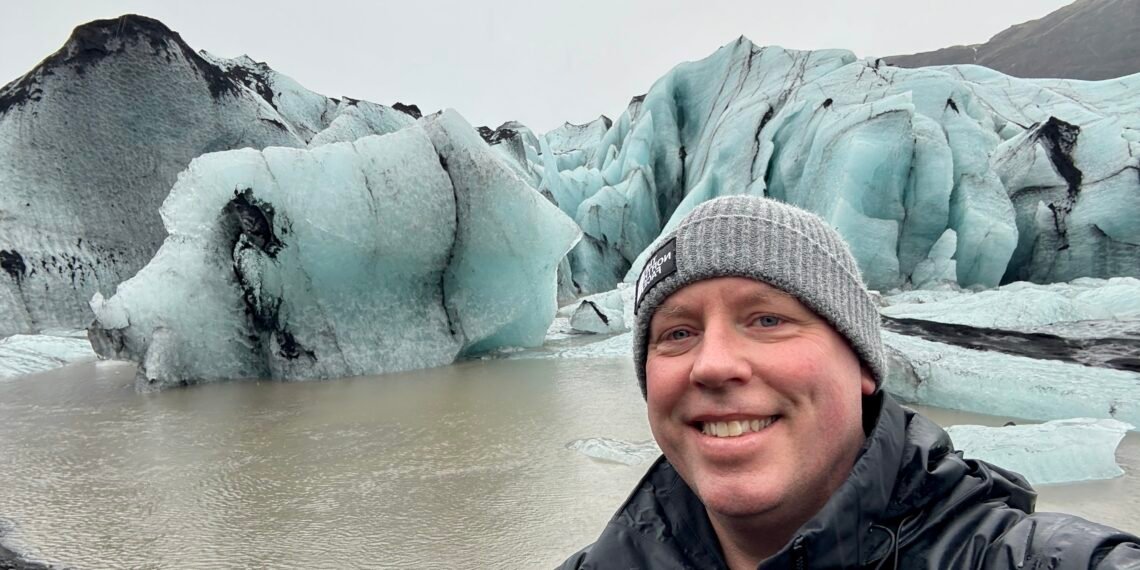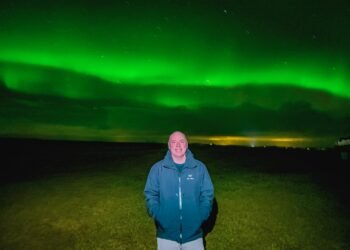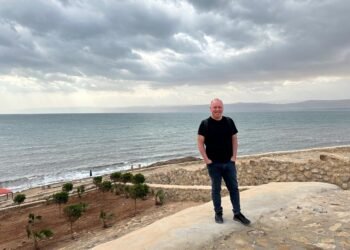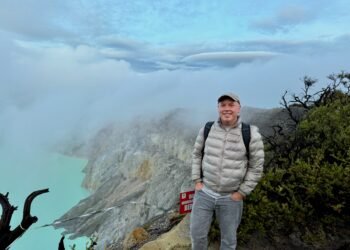I ventured to the Sólheimajökull glacier in southern Iceland on a rain-soaked February day, driving from the nearby town of Vík. Despite the unpredictable weather, the glacier’s ancient ice—streaked with volcanic ash—left me in awe. Seeing firsthand how much it has receded reminded me of the global impact of climate change, much like my past visit to the Mer de Glace in France. Through this journey, I not only explored the glacier’s mesmerizing terrain but also deepened my understanding of the fragile balance between Iceland’s fiery volcanoes and its ever-shifting sheets of ice.
Disclosure: Some of the links in this article are affiliate links, which means I may earn a small commission—at no additional cost to you—if you book or purchase through them. Rest assured, I only recommend places or services I’ve personally tried and enjoyed.
A Rain-Soaked Arrival at Sólheimajökull
The first time I heard about Sólheimajökull, I imagined a stark, glistening expanse of white and blue, looming beneath an overcast Icelandic sky. Something about glaciers has always enthralled me—a combination of their timeless majesty and the very real threats they face in a warming world. Yet no amount of online reading or watching videos could truly prepare me for the day I would stand at the glacier’s edge, confronting its ancient ice face to face.
My trip to Sólheimajökull took place in February, a month known in Iceland for fickle weather, heavy rains, and a raw, elemental beauty. Indeed, it rained every day during my time in the region. But the prospect of seeing the southern coast’s famed glaciers and volcanic landscapes was enough to make me embrace the dampness. In a land where fire meets ice, a little rain felt like a fitting introduction.
Little did I know, that damp, 40-minute drive from the town of Vík to Sólheimajökull would become one of the most memorable journeys of my life. Over the course of a single day, I’d witness a glacier in flux—marred by black volcanic ash, riddled with cracks, and alive with hidden meltwater channels—while grappling with the staggering reality that this incredible wonder may be drastically different for future generations.
Quick Facts: Sólheimajökull Glacier
- Location: A glacial tongue of the larger Mýrdalsjökull ice cap in southern Iceland.
- Age of Ice: Some sections of the ice are estimated to be around 60,000 years old.
- Volcanic Influence: The glacier is often marked by black volcanic ash due to the nearby Katla volcano beneath Mýrdalsjökull.
- Accessibility: Approximately a 2.5 to 3-hour drive from Reykjavík or a 40-minute drive from the town of Vík.
- Hike Duration: About a 15–20-minute walk from the parking lot to the glacier’s edge.
- Retreat and Climate Change: Sólheimajökull has retreated over 200 meters in recent decades, illustrating the effects of global warming.
- Seasonal Conditions: Winter months can bring heavy rainfall or snow; crampons and guided tours are recommended for glacier walks.
The Road from Vík: A Wet and Wondrous Drive
I started my day at the cozy Lindartún Guesthouse in Lindartún, savoring a hot cup of coffee while planning my itinerary. After breakfast, I set out on the Ring Road heading east toward Vík, a picturesque coastal village known for its black sand beaches and dramatic Reynisdrangar Cliffs. I spent the morning exploring those towering basalt sea stacks and soaking in the rugged shoreline vistas. In the afternoon, I continued my journey to the Sólheimajökull glacier, eager to witness its ancient ice and volcanic contrasts firsthand.
The drive itself was a visual feast. Layers of low-lying clouds clung to jagged mountain peaks, and the February rain persisted in waves—heavy at times, gentle at others. Moss-covered lava fields unfurled on both sides of the road, and I spotted the occasional Icelandic horse grazing on soggy grass. Despite the gray skies, the sense of anticipation lit a spark in my chest.
I reached the turnoff to Sólheimajökull in about 40 minutes. By then, the wind had picked up, as though heralding the glacier’s presence. When I finally pulled into the parking lot, my winter jacket was already dotted with droplets, and a brisk gust tugged at the car door the moment I opened it. This felt like Iceland at its most dramatic—and I loved every second.
The Walk to the Glacier Face
From the parking lot, it’s about a 15-minute walk to the glacier’s tongue—a path that meanders through volcanic rock and gravel. Before setting out, I pulled my hood tight and double-checked my boots; the rain showed no sign of relenting. Along the trail, a steady flow of curious travelers passed by, looking jubilant after witnessing the glacier. Many carried the necessary gear—crampons, helmets, and ice axes—indicating they’d ventured onto the glacier itself.
The glacial lagoon at the lower end of the glacier itself was mesmerizing: a slate-gray body of water dotted with ice chunks that had calved from the glacier. These floating ice blocks ranged from small, jagged shards to sizable bergs slowly drifting in the current, their surfaces streaked with white, blue, and black. It struck me as a poignant illustration of the glacier’s ceaseless dynamism. At certain points, I could see how the lagoon’s water flowed outward toward the sea, a reminder that everything in nature is interconnected—from the snowfall high in the mountains to the ocean’s lapping waves.
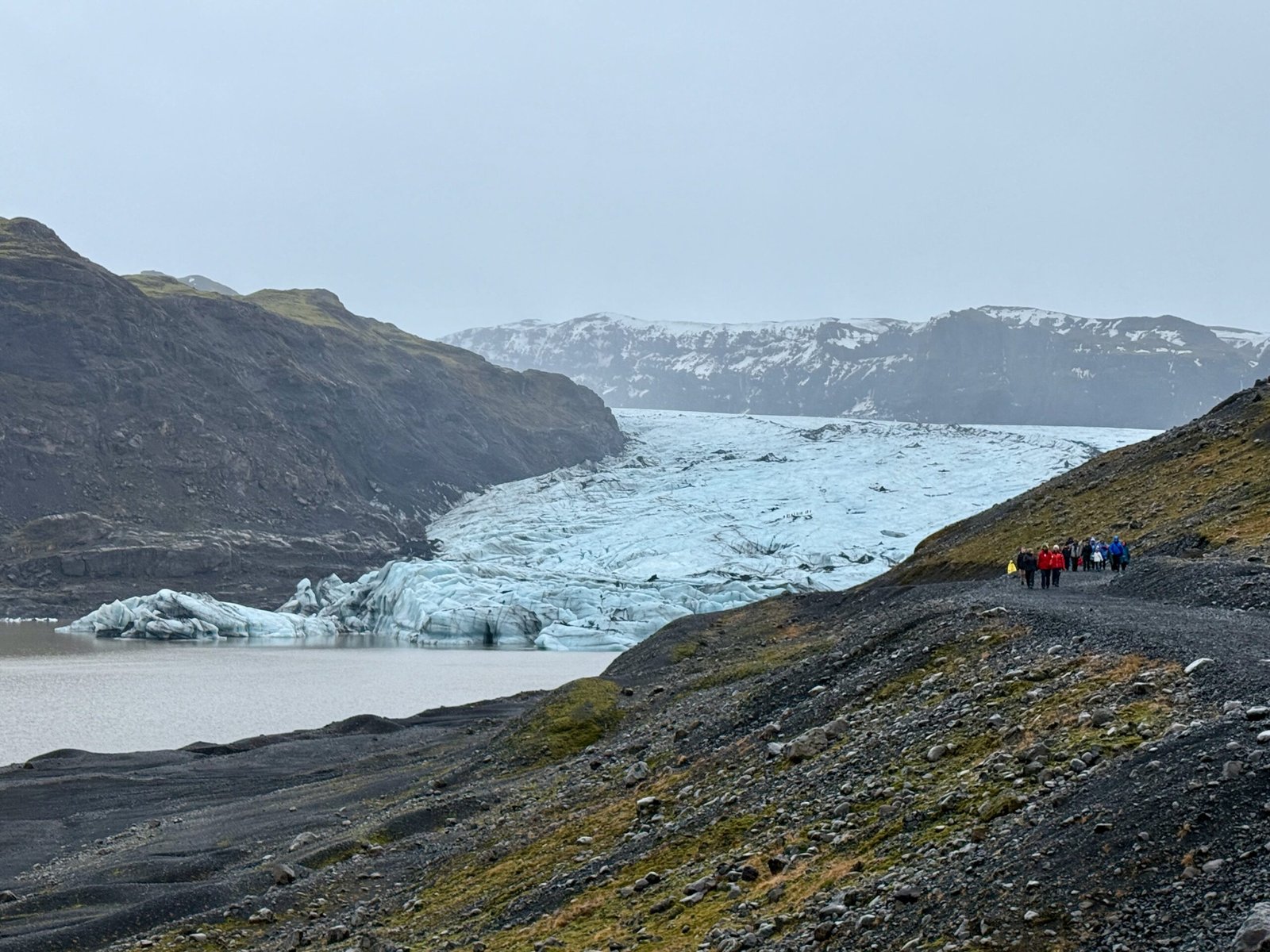
At last, the glacier came into view. Even beneath a veil of steady rainfall, Sólheimajökull was nothing short of breathtaking. I paused in the drizzle, momentarily forgetting the wetness soaking into my clothes, and just stared. It reminded me of a giant river of ice slithering down between tall, snow-capped mountains. Volcanic ash stained its surface in places, creating a visual contrast between the brilliant whites and blues of the ice. The wind picked up again, sending droplets sideways, and I pulled my jacket tighter. Still, the chill in the air did not dampen my excitement.
First Impressions: An Ancient Marvel
Seeing the glacier in person sparked a sense of awe unlike anything I’d felt before. Sólheimajökull originates from the larger Mýrdalsjökull ice cap high above in the mountains, which in turn sits atop the formidable Katla volcano. This proximity to volcanic activity is what gives Sólheimajökull its trademark streaks of black sand and gravel. It’s a reminder that Iceland is shaped by two opposing forces—volcanic fire and icy cold—forever locked in a dance that defines the island’s landscapes.

Groups of hikers ambled by, some returning from a tour atop the glacier, their crampons in hand and faces red from the cold wind. In the far distance, I could spot other groups, tiny silhouettes moving gingerly across the ice’s surface. Watching them was like observing explorers on another planet, each step deliberate and cautious.
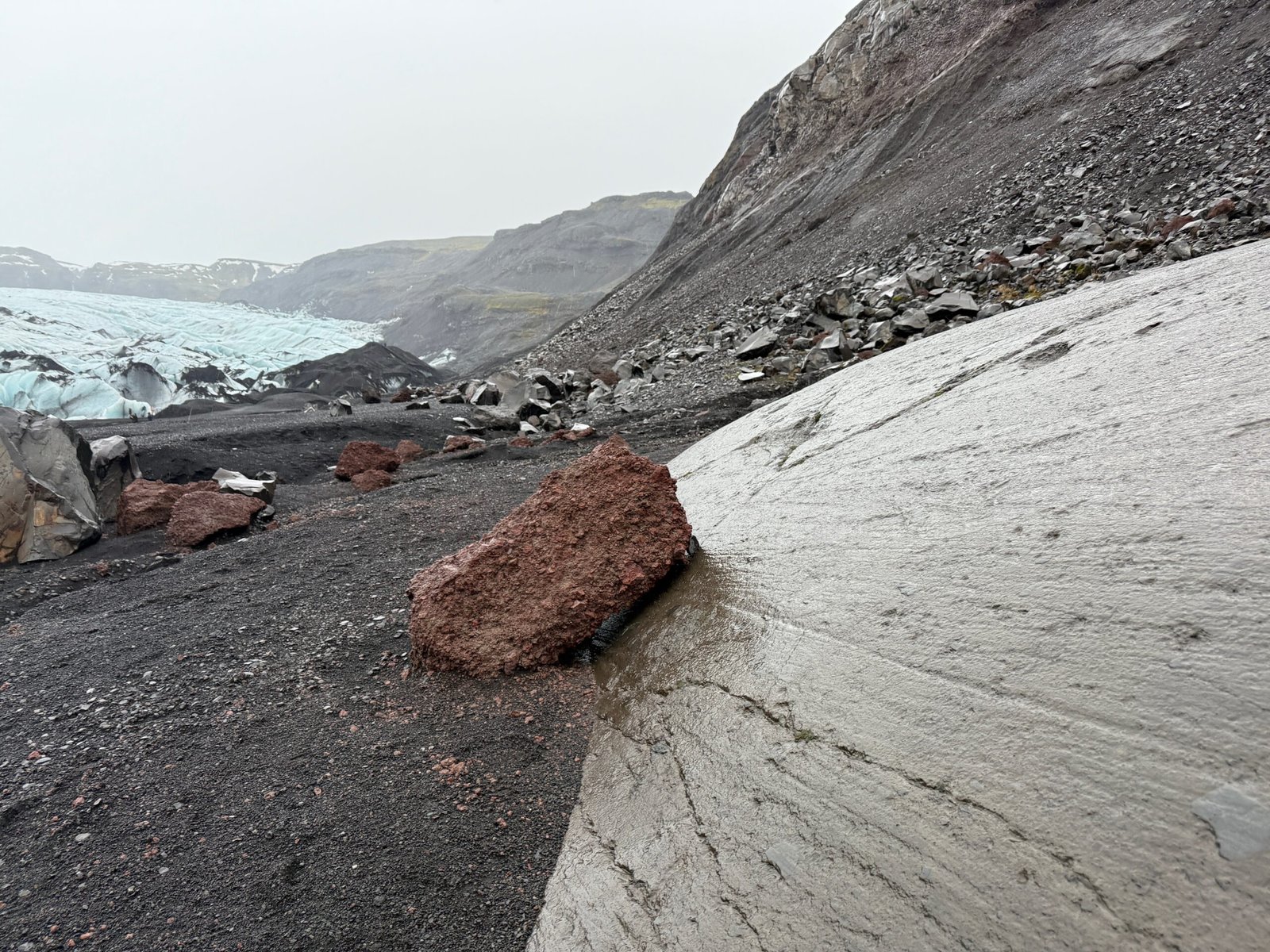
As I ventured closer to the glacier’s terminus, I passed exposed bedrock lining the canyon walls. This rock bore striations—scratches etched into the stone over centuries or millennia—as the ice ground its way down toward the sea. It was humbling to see such evidence of the glacier’s power, an echo of a past I could scarcely fathom. More volcanic stones of varying sizes and shapes littered the terrain, likely transported by the glacier’s slow but relentless motion. Each pebble, each boulder, told a piece of the story of Sólheimajökull’s journey from mountain to plain.

When I finally stood next to the ice, I found myself compelled to reach out and touch it—an almost instinctive desire to connect physically with something so ancient. My fingers sank into the chilly surface, soaking up its story. Later, I’d learn that much of the ice here could be around 60,000 years old. Thinking about that number sent a shiver through me. Sixty thousand years! How many storms had this ice weathered? How many climatic shifts had it endured?
“In that moment, I felt the weight of 60,000 years of Earth’s history beneath my fingertips—ancient, fragile, and melting faster every year.”
Weathering the Elements
If there’s one constant in Iceland, it’s the unpredictability of weather. This visit was no exception. Every so often, the rain became more intense, the droplets pelting my hood with a staccato rhythm. In those moments, I felt entirely at the mercy of nature—an exhilarating sensation, if a bit soggy. I could feel water trickling down the back of my neck, but the excitement of being there overshadowed any discomfort.
It helped to see that I wasn’t alone in braving the elements. Other travelers, bundled in waterproof layers, trudged up and down the path, some snapping photos and others simply gazing in astonishment. A few looked cold and tired, yet none seemed to regret their choice to visit under such conditions. This is Iceland, after all, and part of the magic lies in embracing whatever nature throws your way.
Sólheimajökull in Science: A Retreating Giant
The more I explore glaciers around the world, the more acutely I become aware of their fragility—Sólheimajökull is no exception. Scientists estimate that Iceland’s glaciers have been retreating at an alarming rate, with Sólheimajökull particularly vulnerable due to its relatively low elevation and the warming influence of the Atlantic.

One visual cue of this retreat was right before my eyes: the glacier’s current face sat some 200 meters back from where it once filled the canyon. That space is now occupied by the glacial lagoon I had just passed, a place that didn’t exist mere decades ago. The retreat reminded me of another iconic glacier I visited years ago—the Mer de Glace in Chamonix, France. There, too, I saw how dramatic the ice loss had been over the past century. If you’re curious about that experience and the parallels between these two glaciers, check out my other article, Mer de Glace: Discover the Stunning Science and Alarming Impact of France’s Longest Glacier.
Observing these transformations firsthand makes the abstract concept of climate change far more tangible. You’re not just looking at numbers on a graph; you’re standing on soggy earth that used to be under ice, gazing at a glacier that’s visibly thinner and shorter than it was mere years ago. It’s at once awe-inspiring and sobering, filling me with a sense of urgency to protect what remains.
Touching Time: My Personal Connection
Despite the serious undertone of climate change, I couldn’t help but feel wonder as I ran my hand across the ice. In that act—simple as it was—I felt as though I was bridging an unimaginable gulf of time. How many storms, eruptions, and shifting weather patterns had shaped this particular stretch of ice? The knowledge that some of this ice dated back tens of thousands of years filled me with reverence.
There’s also a personal satisfaction that comes from visiting a place you’ve dreamt about. After reading about Sólheimajökull for so long, to finally stand there with rain streaming down my face, to see its shimmering colors—white, cobalt blue, streaks of black—I felt more alive, more grateful for the chance to witness this slice of Earth’s history before it changes even further.
Reflecting on the Impact of Change
Taking one last look at the glacier, I tried to imagine how it must have looked decades or centuries ago, perhaps flowing all the way to the mouth of the canyon. Now, it’s definitely smaller. And though we can’t see glacier retreat happen in real-time, the signs are everywhere—the newly formed lagoon, the exposed bedrock, the fresh boulders scattered about.
Comparisons with my past glacier explorations underscore just how global these shifts are. Mer de Glace, the Alaskan glaciers in the United States, the Patagonian ice fields in South America—all are receding, marking time in a way that’s both visually striking and haunting. It’s a reminder that climate change is not an abstract phenomenon; it’s personal, physical, and heartbreakingly evident.
Back to the Parking Lot: A Rain-Soaked Return
The wind and rain persisted as I retraced my steps along the volcanic path. But something inside me had shifted. I felt energized, deeply humbled, and even more curious about what other icy realms are undergoing similar transformations. My clothes clung to me, soaked through, yet I couldn’t bring myself to care too much. Seeing Sólheimajökull had been worth every drop of rain.
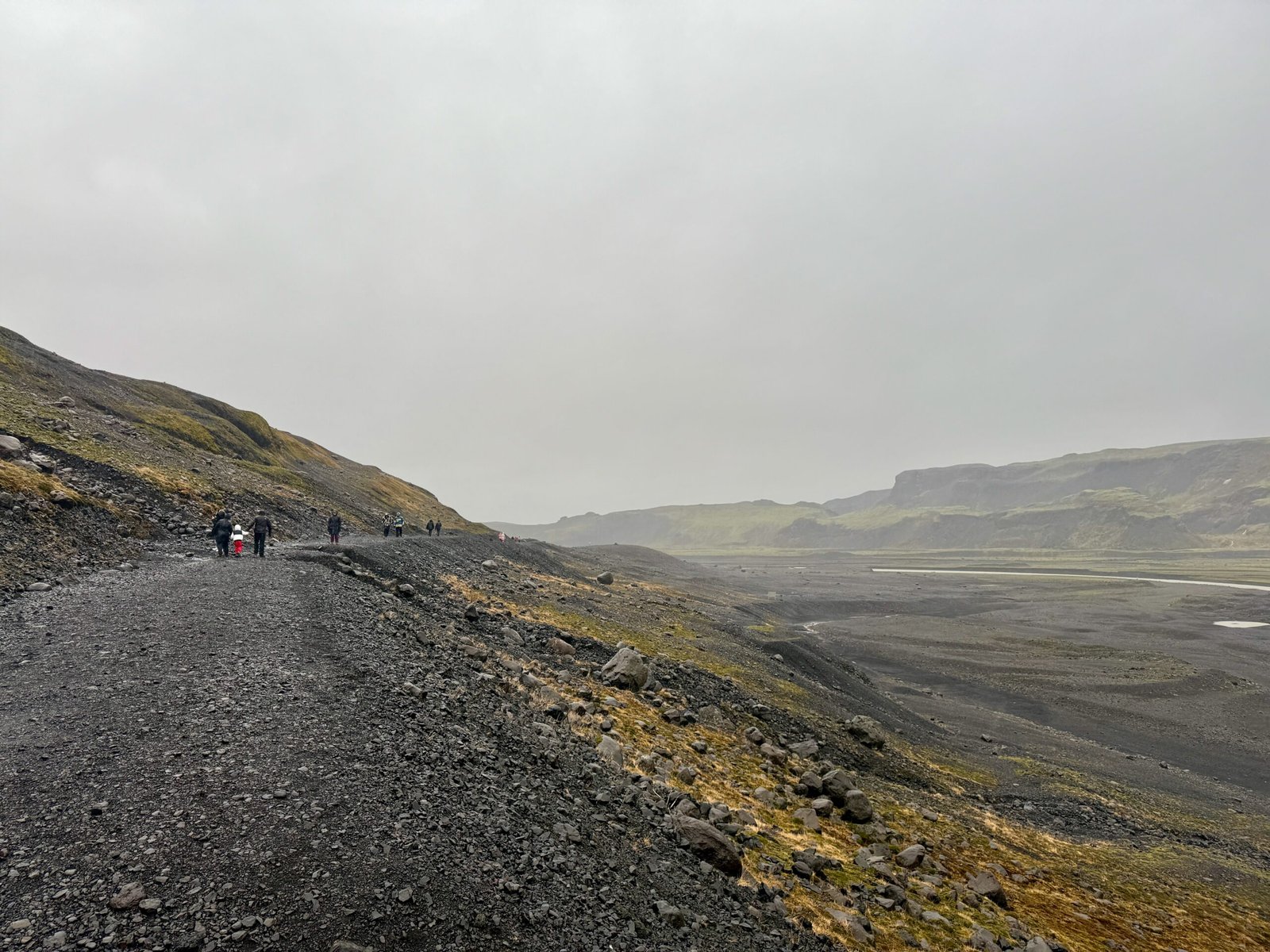
As I climbed back into my rental car, the heater’s warm air felt heavenly against my cold hands. Still, I lingered a moment, watching new groups arrive. Some were donning bright rain jackets, while others double-checked their crampons. I silently wished them a safe and enlightening journey. Then, I started the engine, feeling a profound sense of privilege and responsibility. By witnessing this glacier at its home in the “land of fire and ice,” I was now a firsthand witness to an ancient marvel in transition. And as I pulled away, I carried with me a renewed drive to share its story.
Practical Travel Tips
If you’re planning to experience Sólheimajökull for yourself—and I highly recommend that you do—here are some practical tips to make your trip safe, comfortable, and memorable:
- When to Go: Visiting in February offers a wintry landscape with fewer crowds, though expect heavy rainfall or even snowfall. Weathercan be unpredictable year-round; dress accordingly.
- Getting There: The drive from Vík to Sólheimajökull takes about 40 minutes. Keep an eye on weather forecasts and road conditions; Icelandic roads can become treacherous under winter storms. Having a rental car is ideal for exploring at your own pace. Just be prepared for potential high winds and slippery roads.
- What to Wear: Layering is essential: wear moisture-wicking base layers, insulating mid-layers (fleece or down), and a waterproof jacket and pants on top. Waterproof boots with good traction are a must. In glacier terrain, you might also need crampons—these are typically provided if you join a guided tour.
- Glacier Access: It’s about a 15-minute walk from the parking lot to the glacier’s edge. The path can be muddy or icy, so watch your step. If you plan to walk on the glacier itself, consider a guided tour. Do not venture onto the ice alone unless you’re an experienced mountaineer with proper equipment.
- Dealing with Rain: Sólheimajökull sees its fair share of wet weather. Bring a sturdy umbrella or a waterproof camera sleeve if you’re planning on taking photos or videos. Quick-dry clothing and spare socks can be lifesavers on a rainy day.
- Facilities: There’s limited infrastructure around the glacier—essentially a parking area and sometimes a small café or food truck (depending on the season). Bring snacks and water to stay energized.
- Photography Tips: For capturing the striking blues in the ice, use a polarizing filter to cut glare. Keep extra batteries warm (in a pocket close to your body) to prevent them from draining quickly in the cold. Don’t forget a microfiber cloth to wipe water droplets off your lens in the rain.
- Safety First: Weather can shift rapidly in Iceland. If conditions worsen, turn back and reschedule your visit rather than risk being stranded or caught in dangerous situations. Check the Icelandic Meteorological Office for warnings on storms or extreme conditions.
Pro Tips for the Science Traveler
For those who, like me, love combining adventure with a deep dive into geology, climate science, and the marvels of our planet, here are a few pro tips to enhance your learning experience:
- Brush Up on Glaciology: A basic understanding of glacial formations—terms like “crevasse,” “serac,” “moulin,” or “calving”—can greatly enrich your visit. Reading scientific papers or popular science articles on Icelandic glaciology prior to your trip adds context.
- Ask the Experts: Guided glacier tours often feature knowledgeable guides who can explain everything from the ash layers in the ice to the processes behind glacial retreat. Don’t be shy—ask about volcanic influence, local weather patterns, or the age of the ice.
- Keep a Field Journal: Jot down weather conditions, observations of the ice, and changes in the landscape you notice. If you visit Iceland again or explore other glaciers, you can compare your notes over time. Documenting your experience can also help scientists if you share photos or observations with research communities.
- Extend Your Learning: Combine Sólheimajökull with other scientific and geological sites in Iceland: visit geothermal areas near Geysir, explore the rift valley at Þingvellir National Park, or check out other glacial tongues around Mýrdalsjökull. Broaden your perspective by examining how all these forces—volcanoes, glaciers, tectonic plates—interact.
- Global Comparisons: If you’re fascinated by glaciers, visit others around the world. Compare Sólheimajökull to Mer de Glace in France, Patagonia’s glaciers, or those in Alaska. Each glacier reveals a different facet of climate science. My personal experience at Mer de Glace was eye-opening in terms of how global warming affects different regions.
- Engage in Citizen Science: Look for volunteer projects where you can help measure meltwater, document ice retreat, or take regular photographs from fixed vantage points. Even if you’re just a curious traveler, your photographic records could be valuable to researchers tracking changes over the years.
- Stay Informed: Climate science evolves quickly. Keep tabs on credible sources like the Icelandic Meteorological Office and international journals for the latest research on glacier dynamics. Follow local conservation groups, and consider supporting initiatives aimed at glacier preservation or sustainable tourism in Iceland.
By blending hands-on exploration with a scientific mindset, you transform a typical touristic outing into a meaningful expedition. It’s not just about snapping pictures; it’s about connecting the dots between geology, climate, and the living, breathing Earth beneath our feet.
Final Reflections: A Rain-Soaked Revelation
My day at Sólheimajökull ended as it began—with the rhythmic patter of rain on my car’s roof. The difference was that I’d now walked in the shadow of an ancient glacier, touched its millennia-old ice, and witnessed the undeniable scars of change carved into the Earth. The soggy jacket and wet socks seemed a small price to pay for such a humbling experience.
Iceland is often called “the land of fire and ice,” and Sólheimajökull captures that duality perfectly. Volcanic ash merges with frozen water; molten rock lies beneath ancient ice. Standing at this intersection of opposing forces, I felt simultaneously minuscule and deeply connected to something primordial. The memory of the glacier’s formidable presence—its deep crevasses, vibrant blue hues, and soft murmur of meltwater—lingers like a vivid dream.
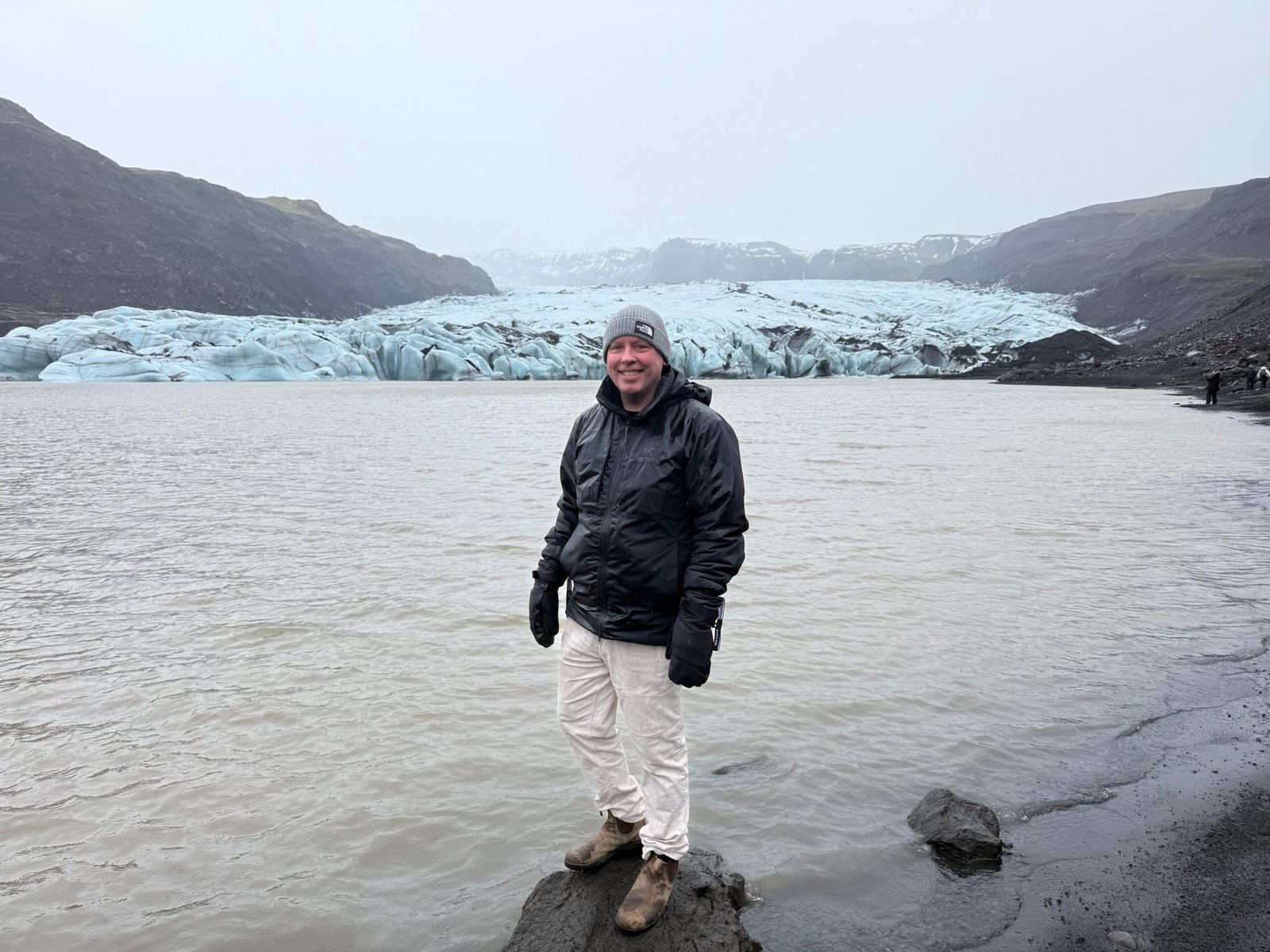
As the rain slowed, I thought about the future of Sólheimajökull and glaciers worldwide. Each is a sentinel, recording Earth’s climate history in its layers. But these sentinels are slowly receding, their archives melting away into the ocean. It’s a stark reminder that our actions ripple through ecosystems far beyond our immediate surroundings.
Yet, hope remains. Witnessing these changes can galvanize us to protect what’s left. Whether it’s adjusting our personal habits, supporting conservation initiatives, or simply sharing our stories to raise awareness, every bit matters. My parting thought as I drove away was one of gratitude: for the privilege of seeing Sólheimajökull with my own eyes and for the chance to tell its story—hoping that it inspires others to treasure and safeguard these rare, breathtaking remnants of Earth’s ancient past.

